Bristol Blenheim L9415, Donegal, December 1940
On the 21st of December 1940, Blenheim L9415 of RAF 272
Squadron Aircraft took off from RAF Aldergrove outside Belfast
to carry out a convoy escort mission over the north Atlantic. On
the return journey the crew of three Royal Air Force Sergeants
encountered bad weather and running low on fuel, were forced to
bale out of the aircraft.
Two of the crew, the pilot Sgt Hobbs and wireless operator/Air
Gunner, Sgt Newport, parachuted to the ground near the Irish
army posts at Fort Lenan and Fort Dunree.
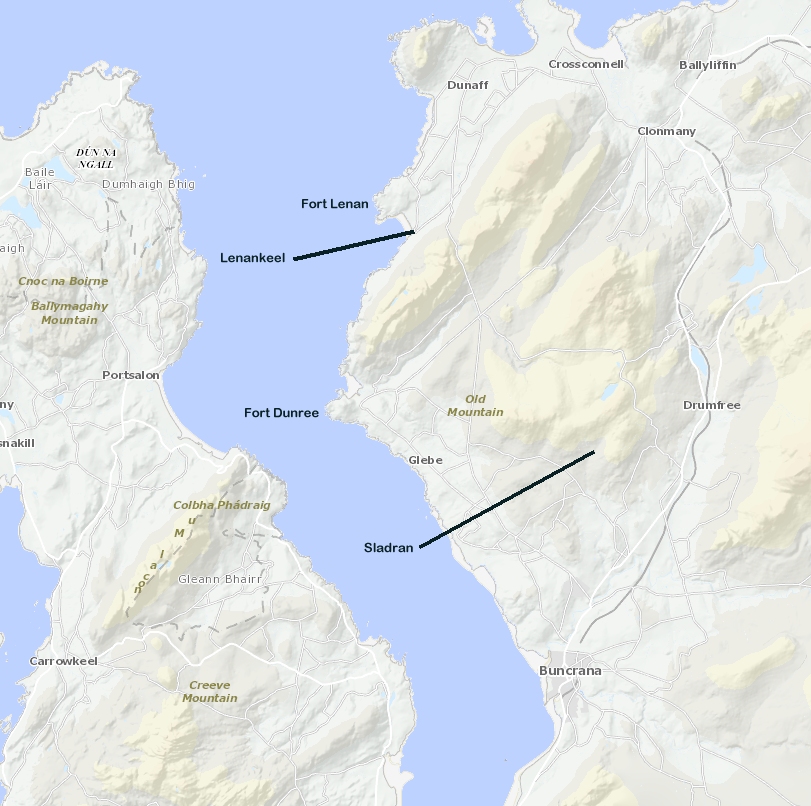
The Irish Government Information Bureau released the following statement to the newspapers on the night of the 22nd December:
"At about 8.15 last night (Saturday) a British 'plane
crashed at Sledrin, some three miles north-east of Buncrana,
Co. Donegal. The 'plane was wrecked. Before the
crash the three members of the crew bailed out. Two were
found soon afterwards They were uninjured and have been
interned. A search for the third offlicer continued
during the night. He was found this morning suffering
from exposure, and is now receiving medical attention".
This was printed in a large selection of Irish, Northern Irish
and Scottish newspapers.
The location where the aircraft came to grief is in many sources
described as Slidrum, Sledrin. The name of the area is and
was then Sladran, near Buncrana.
An RAF Form 765 signed on the 23 December 1940 by the Officer
Commanding 272 Squadron states: Following signal
refers: -
From headquarters, R.A.F.N.I. reference No. D.S.O.2.
dated 21st December 1940, Blenheim L9415 of 272 Squadron of
Aldergrove believed to be aircraft seen over county Donegal
this afternoon as reported by U.K. legation, Dublin. Two
members of crew are safe after parachute descent. Third
member in aircraft still missing. Aircraft believed to
have been short of petrol.
At that point in time, the RAF in Northern Ireland was still
under the impression that Sgt. Ricketts was missing. He
had found himself stuck on a rock in Lough Swilly. On the
morning of the 22nd he swam ashore at Lenankeel and was
initially looked after by a local woman. He was then
brought to the Irish Army post at Fort Lenan hat morning and
kept there under care for two days before being sent onto the
Curragh.
Upon his release in October 1943 from internment, Sgt Ricketts
was interviewed and filed the following Evasion report:
1. Internment
We took off from the R.A.F. station at ALDERGROVE at 1300
hrs on 21 Dec 40 on convoy escort duty. On the return
journey we encountered bad weather, ran out of petrol, and had
to bale out. We landed at the entrance to LOUGH SWILLY,
CO. DONEGAL, and were interned at THE CURRAGH.
The wreckage of the aircraft was brought to Athlone Army
Barracks over 24 - 25 December.
The three crew on the aircraft are first found flying a
shipping escort mission with 272 Squadron on the 23 November
1940, the unit having being formed on the 19th November from an
Aldergrove based detached flight of 235 Squadron. That
flight had been at Aldergrove for over a month They again
flew a convoy escort the following day. They did not fly
an escort mission in December until the 17th. They flew
again on the 20th. The Squadron Operations Record Book
records their next operational missions started at 12.35 on
December 21st but reports only, Crashed in EIRE. interned.
The crew of three had been flying sorties with 235 Squadron from
St Eval in Cornwall since the summer of 1940
Sgt Sydney John HOBBS 742901 Pilot
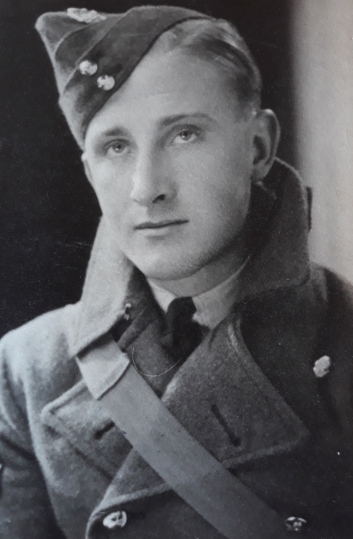 Sydney was born
in July 1916 in Wandsworth, to Alice and of Arthur James Bray
Hobbs. By the time of his internment in the Curragh his
parents lived in Battersea.
Sydney was born
in July 1916 in Wandsworth, to Alice and of Arthur James Bray
Hobbs. By the time of his internment in the Curragh his
parents lived in Battersea.
Sydney also had a letter sent to his father, stopped by
the censor, dated the 23 Dec 1941. In it he had said:
We got into difficulties on Saturday night last and I ordered
the crew to jump, and when they had gone I headed her for the
hills and jumped myself.
Both myself and my air gunner Newport got away with
crooked ankles, but my
Observer landed on a rock in the sea and had to spend the
night there. He
swam to the shore in the morning and is suffering from
exposure. We have
been very kindly treated, but am afraid this camp will
send me off my head in
no time - so will father please do the necessary.
There are three of us
here and none of us want to stay. We still have a
job to do. There are also
three officers with us.
There is absolutely nothing more that that I can
say because there is
nothing that I have done, but when not quite so miserable
I will endeavor to write a longer letter.
Sgt Hobbs was married on 7th June 1941 to his fiance Joan M
Greenland. She had traveled over from England to visit and
they had decided they would be married locally in Ireland near
the Curragh, away from their families and friends. They
would have the pleasure of the internees of the Allied internee
camp instead. The couple then traveled to Dublin and had
their wedding meal in the Clarence Hotel on the banks of the
river Liffey.
Hobbs escaped in July 41 and reported to 143 squadron with
effect from 3 August 1941. He was killed in a flying
accident in Scotland just one month later when Beaufighter T4648
stalled on landing at Dyce on 14 August 1941 with 143 Squadron.
Probate Calendar records address as Flat 3, 4 Orlando Road, Clapham, to widow Joan Moira Hobbs.
Sydney was employed as a draughtsman in the Deptford Board of works, and the organizations journal, Aquarius, published the following obituary and photo in their September 1941 publication.
MR. S. J. HOBBS
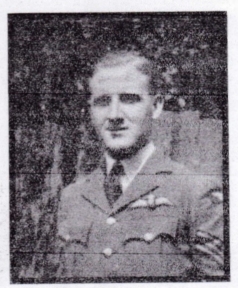 Many people in the
Board, especially in the Kent Area, will hear with sorrow of
the death of Sergeant Pilot S. J. Hobbs in a flying accident
at Aberdeen on Thursday, August 14th, but his colleagues at
Deptford
Many people in the
Board, especially in the Kent Area, will hear with sorrow of
the death of Sergeant Pilot S. J. Hobbs in a flying accident
at Aberdeen on Thursday, August 14th, but his colleagues at
Deptford
will mourn the loss of a friend in whose career they took
a personal pride and whose recent escape from an internment
camp in Eire gave them so much pleasure mixed, alas, with a
too-well-founded anxiety.
Jack Hobbs enjoyed sports which called for speed and a
certain reckless enthusiasm, and his sturdy diminutive figure
was well adapted to rugger, skating and motor cycling,
activities to which flying seemed a natural outlet, and which
he learnt in his spare time a year prior to the outbreak of
war.
In the office he was a neat draughtsman who concentrated
on his work, hut he was also an artist with a flair for
caricature, as the Deptford Staff well know. Beneath a quiet
exterior lay a spirit of independence and a determined will
together with a truly modest and sweet disposition, qualities
which earned the respect and affection of his fellows to a
lasting degree and which were unchanged by his experiences of
the last two years.
He was called up on the day war broke out and entered on
an eventful and courageous flying career. He was in the early
bombing raids on the Frisian Islands and was over Narvik to
protect our ships, and patrolled the sky and engaged enemy
planes while the troops were being evacuated from the beaches
of Dunkirk. He accompanied bombers in raids on Hamburg
and Bremen, and was in the greatest battle of all - The Battle
of Britain — last autumn.
Our very deep sympathy goes to his family and to his wife
whom he married so recently in Eire just prior to his escape
from internment. From our own sense of loss we can, in
some measure, appreciate what must be the feeling of those who
were bound to him in closer ties.
He was buried, after cremation, in the “R.A.F. Pilots
Corner” at Brookwood Cemetery, at his own request.
Per ardua ad astra P.B.F
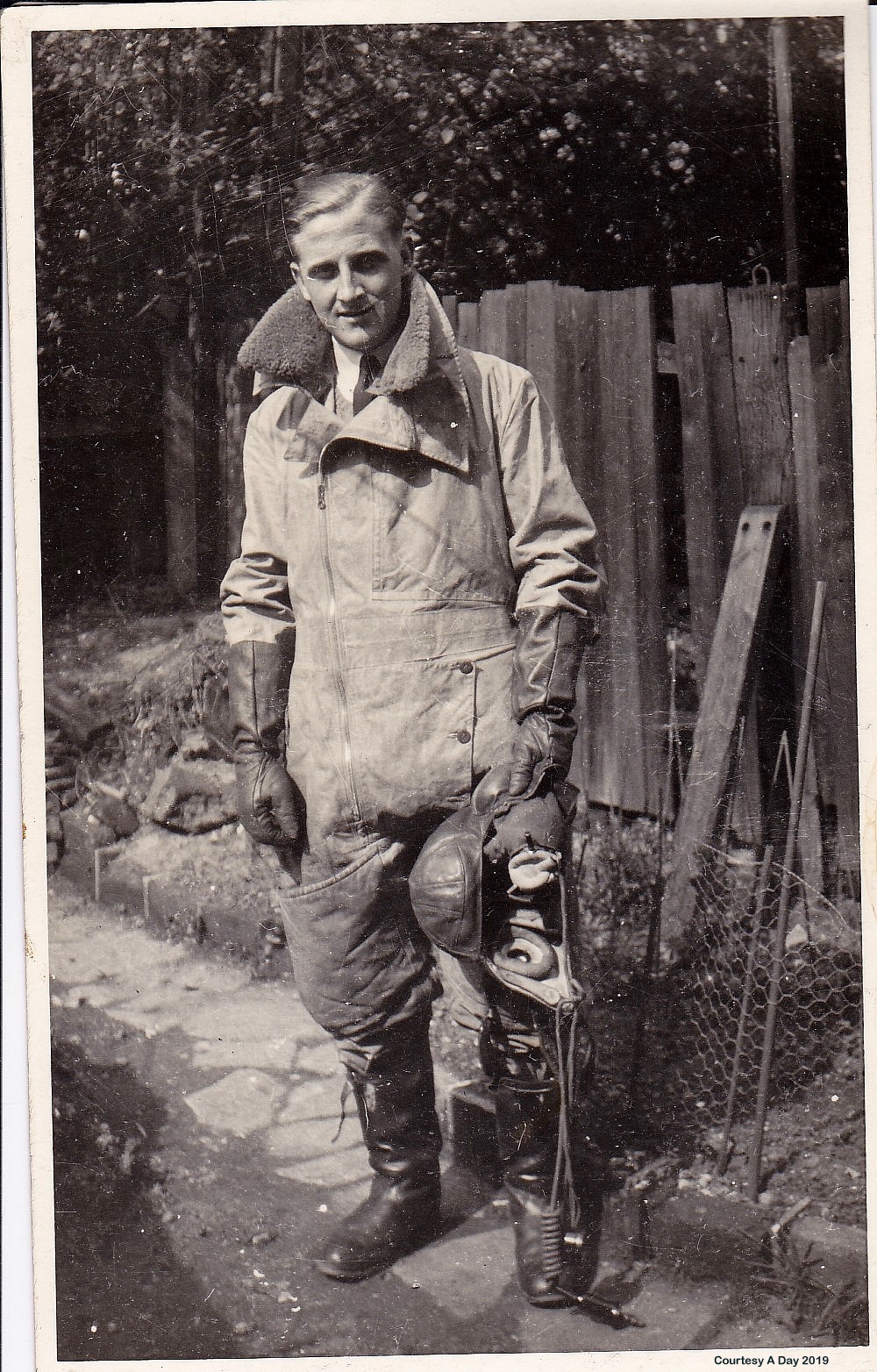
Sydney's young wife Joan, finding herself widowed only weeks
after their marriage, lived until 2006, having never again
married. She did however save and keep a great many photos
and documents relating to Sydney and a large collection of
letters, including a great many letters for her young pilot, and
also from Douglas Newport, written to her from internment in
Ireland. Joan's neice very kindly traveled to Ireland in
2019 to share some of these photos.
Below, a copy of a letter from the Irving Air Chute of Great
Britain company to Sydney Hobbs, sent via the United Kingdom
office in Dublin, confirming that his commanding officer had
provided the official confirmation that the three airmen had
indeed successfully bailed out of their aircraft. The
caterpillar pins referred to were those of the Caterpillar Club,
and were awarded to those who had successfully used an Irving
parachute.
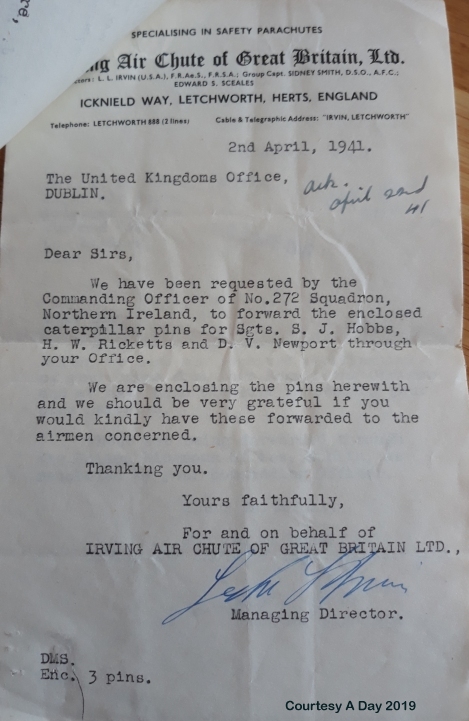
Part of the tradgedy of Sydney Hobbs story was his marriage in
June 1941, only weeks prior to his escape and subsequent death
in the aircraft crash. His wedding to Joan Greenland took
place at Ballysax Church of Ireland chapel near Naas, and was
attended by just some close friends. The image below shows
the wedding party. The two people at the left of the photo
are not known but it is assumed that the lady was the Maria
Dowling named as one of the witnesses at the wedding.
Third from the left is the Reverend Harry V Flint, then Joan and
Sydney Hobbs. The final person is understood to be Douglas
V Newport, Sydney's navigator. This copy of the photo was
marked on the back with a detailed description of the colours of
at the clothing and every persons complexion and
appearance. It is believed that the image was to be
colourized or was the source of colour information for the
person doing the work.
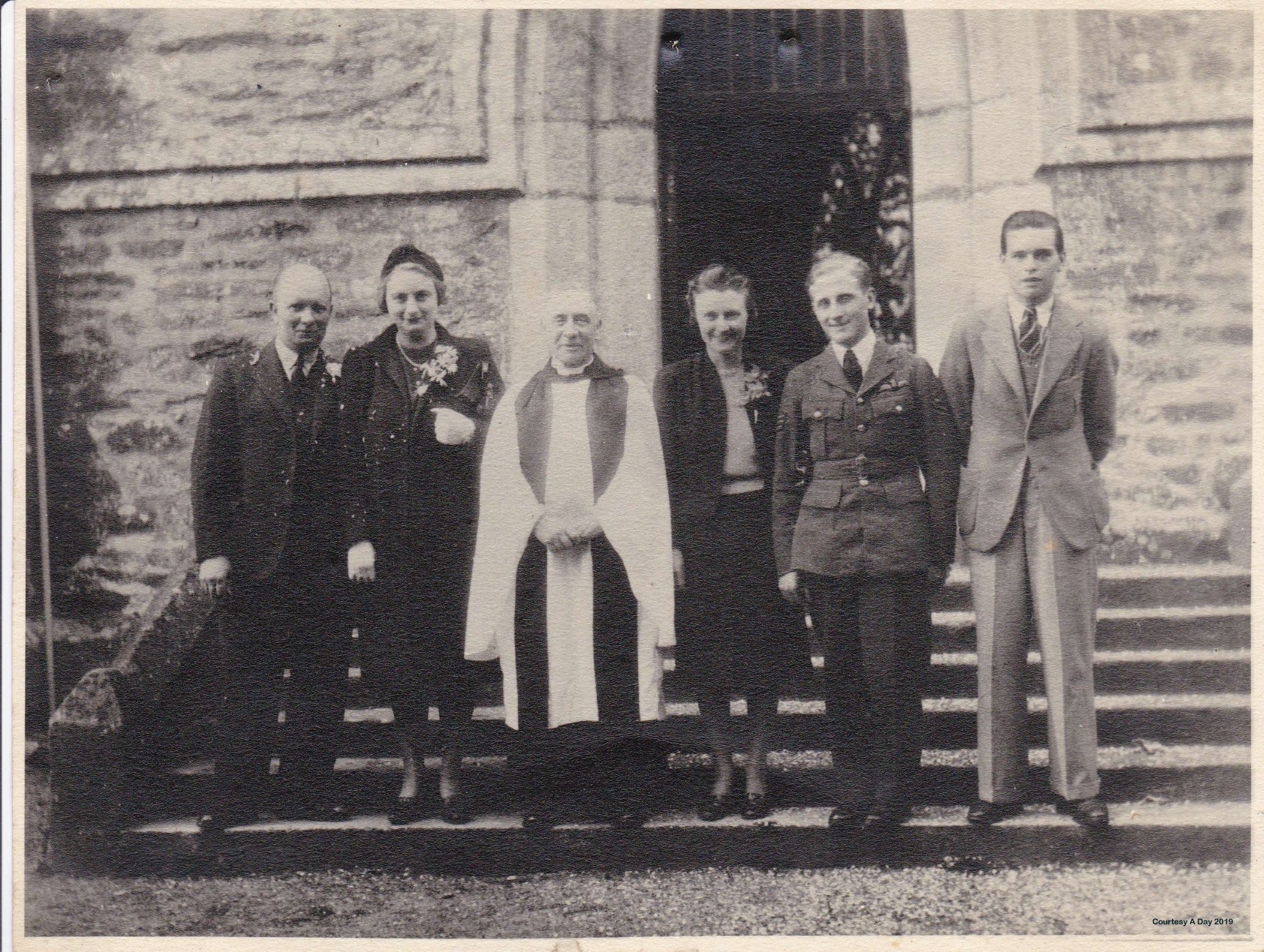
Another photo of the bridal party, with Sydney and Joan in the
center, Douglas Newport on the right and, it is assumed, Maria
Dowling on the right.
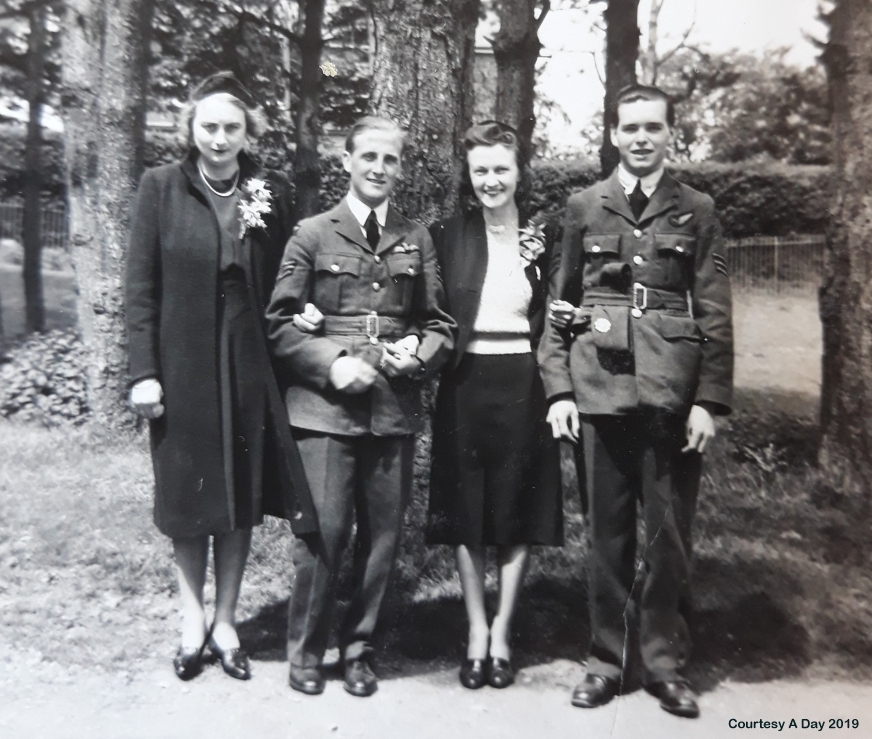
It is not known when the image below was taken exactly, but it
includes both Sgt Hobbs and F/Lt Proctor so is likely to have
been around the time of Sydney Hobbs wedding, though the lady in
the photo does not appear to be his wife Joan. This small
and battered photo shows the following Royal Air Force
internees:
Standing, Left to Right: Herbert Wain RICKETTS, Denys
WELPLY, David SUTHERLAND, Douglas Victor NEWPORT, Leslie John
WARD, Robert George HARKELL, William Allan PROCTOR, George
Victor JEFFERSON and Aubrey Richard COVINGTON.
Kneeling, Left to Right: Norman Vyner TODD, Sydney John
HOBBS.

Among Sydney's items kept by Joan were this letter interning him
in the Curragh, signed by the Irish minister of Defense, Oscar
Traynor on 20th March, 1941.

Sgt Douglas Victor NEWPORT 615682 Wireless Operator /
Air Gunner
 Douglas was
born in October 1920 in Bristol to Florence and Henry G Newport.
Douglas was
born in October 1920 in Bristol to Florence and Henry G Newport.
Douglas had had a letter which he had written to a fellow
airman, stopped by the British censor on or around 5 Jan
1941. The letter contents were summarized as follows in
the censors memo:
“Writer appears to have made a forced parachute descent the
night of 22nd/23rd 12.40
The pilot lost his way 250-300 miles out – the D.F.
calibrations went wrong and A.D.F. bearing became
impossible. S.O.S. & O. sent out for 31/2 hours.
Pilot caught by mountains & cloud at 200 feel.
Petrol gave out – crew baled out – Pilot and Sgt landed safely
with slightly twisted ankles – Observer landed in the sea and
spent night on a rock.
Pilot and Sgt. went to nearest house under the
impression they would be allowed 24 hours in which to leave
the country, but guards arrived within ˝ hours and took men to
a fort.
Writer fears ‘Dick’ must be regarded as missing believed
killed – & thinks he was drowned.
Newport escaped from the Curragh in August 1942 in the Derby Day
breakout, along with five others, and returned to operations
thus is not present in the Tees
wedding photo in 1943. His father was advised by
telegram that Douglas had arrived back in the UK on 4th
September 1942. Douglas returned to flying duties
following his escape. He was it seems posted in 279
Squadron in the middle of December 1943, from XXX. He
continued to fly with this unit on Air Sea Rescue duties until
at least November 1944, and for most of that time served
alongside former internee, pilot F/Lt Denys Welply until his
death in November 1944.
The Hartlepool Northern Daily Mail published a notice of his
wedding on the 6th July 1945.
NEWPORT —COOPER—On 3rd July, at St. Mary's Church. Acklam.
Middlesbrough. W/O Douglas Victor Newport (RAF.), eldest son
of Mr. and Mrs. F. Newport, of Bristol, to Marjorie Cooper
(W.A.A.F.),
Douglas died on 12 December 1969.
Sgt Herbert Wain RICKETTS 581473 Observer
 Bert, as he
was known to friends and family, was initially thought to be
missing by the authorities as he had landed in the sea, and had
had to spend the night clinging to a rock offshore. In the
morning, he swam to shore.
Bert, as he
was known to friends and family, was initially thought to be
missing by the authorities as he had landed in the sea, and had
had to spend the night clinging to a rock offshore. In the
morning, he swam to shore.
Ricketts was released from internment in October 1943 as part of
the general release. He returned to operations and was killed on
31 March 1945 when the Stirling transport he was flying was shot
down over Norway.
Son of William Henry and Bertha Ricketts, of Rowsley,
Derbyshire, died aged 26. He had one brother, John Selwyn
Ricketts, who had served as a soldier during the war. His
mother predeased them in 1934.
Herbert Wain Ricketts of Rowsley, Derbyshire was born on 11th
November 1918 and joined the RAF about June 1939 as a
direct-entry Airman u/t Observer. He completed his training and
was with 235 Squadron in June 1940, serving with it throughout
the Battle of Britain.
He was commissioned in March 1944 gaining officer serial number
54692.
He was posted in with a new crew to 299 Squadron on 7 Dec 1944
from 1665 Heavy Conversion Unit. 299 Squadron was a part
of transport command and provided supply dropping services in
support of airborne troops and resistance movements within
occupied Europe.
The 299 Squadron ORB records only briefly Herbert's duties with
the unit:
9 Feb 1945 – Flew an Air Sea rescue mission and the following
day was posted with F/O Peat to SAS Wivinhoe Park for a week.
He had flown with the same crew on March 23rd on Operation
Varsity,: RHINE. Successfully released glider at
D.Z. “A” by map reading. S/S WARD GLIDER PILOT. Load
1 Jeep, 1 Trailer, and 1 M/C. Weather excellent. L/F
North of Area. Good trip.
Ricketts was killed with the rest of his crew on 31st March 1945
as a Flying Officer Navigator with 299 Squadron, aged 26.
Stirling 5G-R serial LK332 took off from RAF Shepherds Grove at
9pm to drop supplies to the resistance in Numedal, Norway.
Before reaching the target they were shot down by a German night
fighter. The aircraft crashed, burning into a bog.
The other crew members were:
WO PS Brinkworth
Sgt. JA Elliott
Sgt. KC Hayward
F/Lt. R Trevor-Roper
F/O D Peat
The crew are buried at Indre churchyard, Sondeled, Norway.
Probate calendar records address as 22 Chatsworth Road,
Rowsley, with probate to to William Henry Ricketts, Railway man,
his father.
Herbert also appears in this group photo from 1943, at the
extreme left, standing.

Compiled by Dennis Burke, 2021, Dublin and Sligo. A big thank
you to A Day, to the niece and nephews of Bert Ricketts and the
relatives of D V Newport. Also the people of Rowsley
Village.
